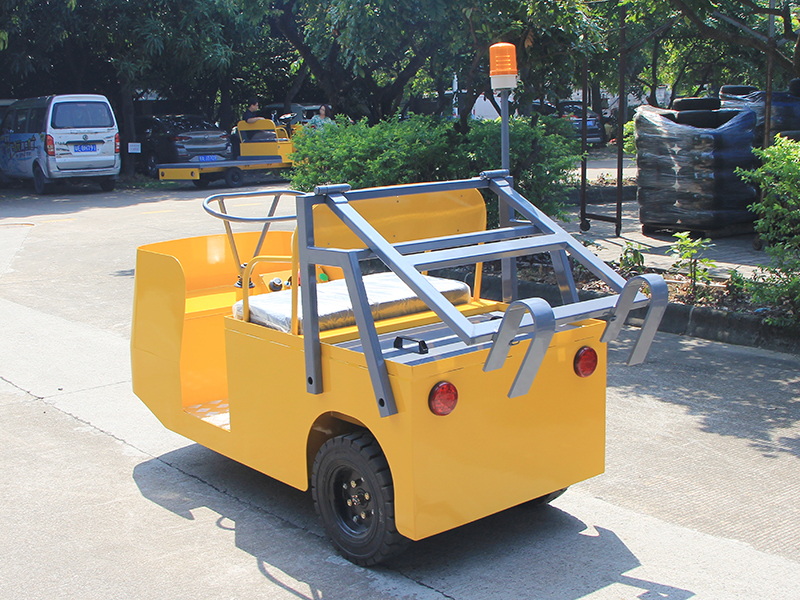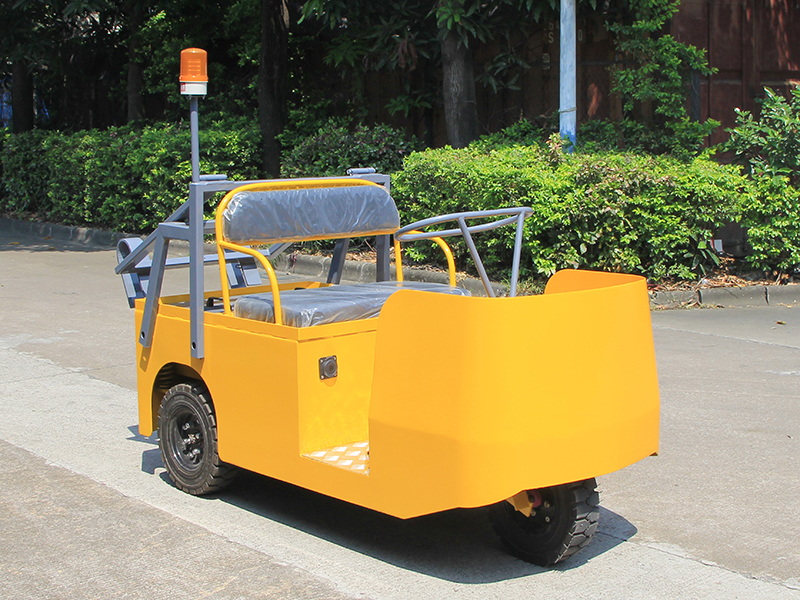Content Menu
● Understanding Electric Towing Tractors
● Cost Factors: Electric vs. Traditional Towing Tractors
>> 1. Fuel and Energy Costs
>> 2. Maintenance Costs
>> 3. Operational Efficiency
● Environmental and Sustainability Benefits
● Practical Considerations for Cost-Effectiveness
>> Battery Management and Maintenance
>> Operator Training
>> Maintenance Best Practices
● Integration with Facility Infrastructure
● Total Cost of Ownership (TCO) Analysis
● Conclusion
● FAQ
>> 1. How often should electric towing tractors be serviced?
>> 2. What are the most common maintenance issues with electric towing tractors?
>> 3. How can I extend the lifespan of my electric towing tractor's battery?
>> 4. What safety precautions should be taken during maintenance?
>> 5. Can I use non-original spare parts for repairs?
Electric towing tractors have become increasingly popular in industries such as aviation, manufacturing, warehousing, and logistics. As companies seek to optimize operational costs and improve sustainability, the question arises: Are electric towing tractors more cost-effective than traditional diesel or gas-powered options? This article explores the financial, operational, and environmental benefits of electric towing tractors, comparing them with traditional models to provide a comprehensive understanding of their cost-effectiveness.

Understanding Electric Towing Tractors
Electric towing tractors are powered by rechargeable batteries and electric motors. They are designed to tow trailers and heavy loads in confined spaces such as warehouses, airports, and manufacturing plants. Unlike traditional diesel or gas-powered tractors, electric models produce zero emissions at the point of use and generally have fewer mechanical components.
Electric towing tractors vary widely in size and capacity, from small models designed to tow light loads over short distances, to heavy-duty tractors capable of moving large aircraft or industrial trailers. Their electric powertrains provide smooth acceleration and precise control, which is especially beneficial in environments requiring careful maneuvering.
Cost Factors: Electric vs. Traditional Towing Tractors
1. Fuel and Energy Costs
One of the most significant cost advantages of electric towing tractors lies in their energy consumption. Traditional tractors rely on diesel or gasoline, which can be expensive and subject to price volatility. Electric tractors, however, run on electricity, which is generally cheaper and more stable in price.
- Electric towing tractors use up to 50% less energy compared to diesel-powered models, significantly reducing fuel expenses.
- For example, Los Angeles International Airport saved over $250,000 annually in fuel costs after switching to electric tow tractors.
- The use of a single power source-a rechargeable battery-eliminates the need for frequent fueling, simplifying operations and reducing labor costs associated with fuel handling.
- Electricity prices tend to be more stable than fossil fuels, which helps organizations better predict and manage operational budgets.
- Additionally, many facilities can take advantage of off-peak electricity rates to charge batteries at a lower cost, further enhancing savings.
2. Maintenance Costs
Maintenance is another area where electric tractors outperform traditional options.
- Electric tractors have fewer moving parts and lack complex fuel, exhaust, and cooling systems, which reduces the likelihood of mechanical failures.
- Maintenance frequency can be reduced by 40%, as seen at Paris Charles de Gaulle Airport, due to fewer breakdowns and simpler structures.
- Annual maintenance costs for electric tractors are about 18% lower than diesel models, with some airports saving around £100,000 yearly.
- Battery life ranges between 6 to 8 years, which is longer than the typical 4 to 5 years overhaul cycle for diesel engines.
- Intelligent monitoring systems in electric tractors can reduce maintenance response times by 30%, enhancing operational uptime.
- Electric tractors do not require oil changes, fuel filter replacements, or exhaust system repairs, which are common and costly in traditional tractors.
- Brake wear is typically reduced due to regenerative braking systems that use the electric motor to slow the vehicle, converting kinetic energy back into battery charge.
3. Operational Efficiency
Electric towing tractors contribute to operational efficiency in several ways:
- They enable a 30% reduction in aircraft ground turnaround time, saving valuable minutes and allowing tighter flight schedules.
- Automated navigation and precise control reduce human errors and improve maneuverability in tight spaces.
- At airports such as Amsterdam Schiphol, switching to electric tractors reduced towing time by 12%, saving 50,000 hours annually and over $1.5 million in operational costs.
- Electric tractors operate quietly, allowing for safer communication and coordination between ground staff, which minimizes delays and accidents.
- Instant torque from electric motors improves responsiveness, enabling faster starts and stops compared to internal combustion engines.
- Electric tractors can be integrated with fleet management software, providing real-time data on usage, battery status, and maintenance needs, which optimizes scheduling and reduces downtime.
Environmental and Sustainability Benefits
While cost savings are crucial, electric towing tractors also offer substantial environmental benefits:
- Zero emissions during operation contribute to improved air quality, especially important in enclosed or urban environments.
- Reduced noise pollution enhances workplace safety and comfort.
- Lower carbon footprint aligns with corporate sustainability goals and regulatory compliance.
- Many airports and industrial sites are adopting green initiatives, and electric tractors help meet these goals by reducing greenhouse gas emissions and particulate matter.
- The shift to electric towing tractors supports compliance with increasingly strict environmental regulations in many countries.
- The use of renewable energy sources to charge electric tractors further amplifies their environmental benefits, potentially reducing carbon emissions to near zero.
- Electric tractors generate less heat than combustion engines, reducing the cooling load in indoor environments and contributing to energy savings.

Practical Considerations for Cost-Effectiveness
Battery Management and Maintenance
Proper battery care is vital to maximizing cost-effectiveness:
- Following manufacturer charging protocols prevents overcharging or deep discharge, which can shorten battery life.
- Intelligent charging systems adjust charging based on usage and battery health, extending battery lifespan and reducing replacement costs.
- Regular cleaning of battery terminals and checking electrolyte levels (for lead-acid batteries) are essential maintenance tasks.
- Battery technology is evolving rapidly, with lithium-ion batteries becoming more common due to their higher energy density, faster charging, and longer cycle life compared to traditional lead-acid batteries.
- Implementing battery swapping systems can minimize downtime by allowing quick replacement of depleted batteries with fully charged ones.
- Monitoring software can track battery health and predict end-of-life, helping plan replacements proactively and avoid unexpected failures.
Operator Training
Well-trained operators contribute to cost savings by:
- Minimizing wear and tear through proper handling.
- Performing daily inspections to catch early issues.
- Following safety and operational protocols to avoid accidents and downtime.
- Training programs should emphasize smooth acceleration and braking to conserve battery power and reduce mechanical stress.
- Familiarity with the tractor's control systems and safety features ensures efficient and safe operation, reducing the risk of costly damage or injury.
- Regular refresher courses help maintain high standards and adapt to new technologies or procedures.
Maintenance Best Practices
Scheduled preventive maintenance includes:
- Lubrication of moving parts.
- Inspection and tightening of fasteners.
- Checking electrical systems, brakes, tires, and safety features.
- Updating software and calibrating sensors where applicable.
- Establishing a maintenance log helps track repairs, replacements, and inspections, improving accountability and planning.
- Partnering with manufacturers or specialized service providers can ensure access to expert knowledge and genuine parts, reducing downtime and repair costs.
- Implementing predictive maintenance technologies, such as vibration analysis and thermal imaging, can detect issues before they cause failures.
Integration with Facility Infrastructure
To maximize the cost-effectiveness of electric towing tractors, facilities must consider infrastructure:
- Installing adequate charging stations that support fast and efficient battery recharging is essential.
- Facilities can implement smart grid technology to optimize energy consumption and reduce peak demand charges.
- Charging stations can be strategically located to minimize downtime and allow charging during breaks or shift changes.
- Integration with renewable energy sources, such as solar panels, can reduce electricity costs and enhance sustainability.
- Facilities should plan for adequate space and safety measures around charging areas, including ventilation and fire protection.
- Data connectivity between tractors and facility management systems enables real-time monitoring and predictive maintenance.
- Investing in modular charging infrastructure allows for scalability as fleet sizes grow.
Total Cost of Ownership (TCO) Analysis
When evaluating cost-effectiveness, organizations should consider the total cost of ownership, which includes:
- Initial purchase price: Electric tractors often have a higher upfront cost than diesel models, but this gap is narrowing with technological advances and increased production.
- Energy costs: Electricity is cheaper and more stable than diesel or gasoline.
- Maintenance and repair: Lower for electric tractors due to fewer moving parts and simpler systems.
- Downtime costs: Reduced downtime from fewer breakdowns and faster maintenance.
- Resale value: Electric tractors may retain value better due to increasing demand for green equipment.
- Environmental compliance costs: Electric tractors help avoid fees or penalties related to emissions.
- Incentives and subsidies: Many governments offer grants, tax credits, or rebates for electric vehicle purchases, improving financial viability.
- Fleet management savings: Improved data and control reduce operational inefficiencies and labor costs.
A detailed TCO analysis often reveals that electric towing tractors become more economical than traditional options within 2 to 4 years of operation, depending on usage intensity and local energy prices.
Conclusion
Electric towing tractors are more cost-effective than traditional diesel or gas-powered options when considering fuel savings, reduced maintenance costs, and improved operational efficiency. Their longer lifespan, lower environmental impact, and advanced monitoring systems further enhance their value. While the initial investment may be higher, the total cost of ownership over time favors electric models, making them a smart choice for industries aiming to optimize costs and sustainability. Additionally, the environmental benefits and regulatory compliance advantages position electric towing tractors as a forward-thinking solution in modern industrial operations.

FAQ
1. How often should electric towing tractors be serviced?
Electric towing tractors should undergo daily inspections before use and scheduled preventive maintenance quarterly or every 500 operating hours, depending on manufacturer recommendations. Regular checks of batteries, brakes, tires, and electrical systems are essential to maintain performance and safety.
2. What are the most common maintenance issues with electric towing tractors?
Common issues include battery degradation, electrical connection wear, tire wear, and mechanical component lubrication needs. Intelligent monitoring systems help detect these problems early, allowing timely intervention and reducing downtime.
3. How can I extend the lifespan of my electric towing tractor's battery?
Avoid overcharging and deep discharging, keep terminals clean, maintain electrolyte levels if applicable, and use intelligent charging systems to optimize battery health. Implementing battery swapping and monitoring software also helps prolong battery life.
4. What safety precautions should be taken during maintenance?
Always disconnect power sources before maintenance, wear appropriate personal protective equipment, follow manufacturer guidelines, and ensure proper training for maintenance personnel. Proper handling of batteries and electrical components is critical to avoid injury.
5. Can I use non-original spare parts for repairs?
Using original parts is recommended to maintain performance, safety, and warranty coverage. Non-original parts may compromise reliability and increase long-term costs, potentially leading to more frequent repairs or failures.



















































